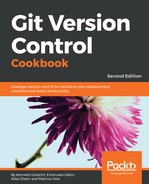The git gc command optimizes the repository by compressing file revisions and deleting objects that there are no references to. The objects can be commits, and so on. On an abandoned (deleted) branch, blobs from invocations of git add, commits discarded/redone with git commit --amend, or other commands can leave objects behind. Objects are, by default, already compressed with zlib when they are created and, when moved into the pack file, Git makes sure to only store the necessary changes. For example, if you change only a single line in a large file, storing the entire file in the pack file again would waste a bit of space. Instead, Git stores the latest file as a whole in the pack file and only the delta for the older version. This is pretty smart, as you are more likely to require the latest version of the file, and Git doesn't have to do delta calculations for this. This might seem like a contradiction to the information from Chapter 1, Navigating Git, where we learned that Git stores snapshots and not deltas. However, remember how the snapshot is made. Git hashes all of the file content in blobs, makes tree and commit objects, and the commit object describes the full tree state with the root-tree sha-1 hash. Storing objects inside the pack-files has no effect on the computation of the tree state. When you check out an earlier version of commit, Git makes sure the sha-1 hashes match the branch, commit, or tag you requested.
 How it works...
by Aske Olsson, Rasmus Voss, Emanuele Zattin, Kenneth Geisshirt
Git Version Control Cookbook
How it works...
by Aske Olsson, Rasmus Voss, Emanuele Zattin, Kenneth Geisshirt
Git Version Control Cookbook
- Title Page
- Copyright and Credits
- Packt Upsell
- Contributors
- Preface
- Navigating Git
- Configuration
- Branching, Merging, and Options
- Rebasing Regularly and Interactively, and Other Use Cases
- Storing Additional Information in Your Repository
- Extracting Data from the Repository
- Enhancing Your Daily Work with Git Hooks, Aliases, and Scripts
- Recovering from Mistakes
- Introduction
- Undo – Remove a commit completely
- Undo – Remove a commit and retain changes to files
- Undo – Remove a commit and retain changes in the staging area
- Undo – Working with a dirty area
- Redo – Recreate the latest commit with new changes
- Revert – Undo the changes introduced by a commit
- Reverting a merge
- Viewing past Git actions with git reflog
- Finding lost changes with git fsck
- Repository Maintenance
- Introduction
- Pruning remote branches
- Running garbage collection manually
- Turning off automatic garbage collection
- Splitting a repository
- Rewriting history – changing a single file
- Creating a backup of your repositories as mirror repositories
- A quick "how-to" submodule
- Subtree merging
- Submodule versus subtree merging
- Patching and Offline Sharing
- Tips and Tricks
- Git Providers, Integrations, and Clients
- Other Books You May Enjoy
How it works...
-
No Comment
..................Content has been hidden....................
You can't read the all page of ebook, please click here login for view all page.